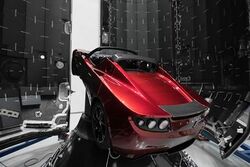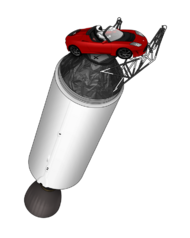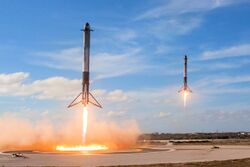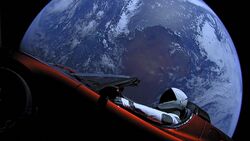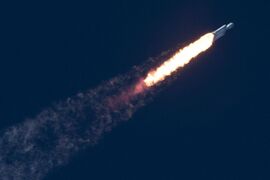Engineering:Falcon Heavy test flight
 Falcon Heavy launching from LC-39A | |
| Falcon Heavy launch | |
|---|---|
| Launch | February 6, 2018, 20:45 UTC |
| Operator | SpaceX |
| Pad | Kennedy LC-39A |
| Payload | Elon Musk's Tesla Roadster |
| Outcome | Success |
| Components | |
| Boosters | B1023 and B1025 |
| First stage | B1033 |
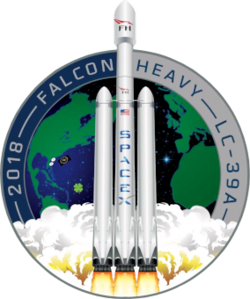 | |
| Official insignia for the flight | |
| Falcon launches | |
The Falcon Heavy test flight (also known as the Falcon Heavy demonstration mission) was the first attempt by SpaceX to launch a Falcon Heavy rocket on February 6, 2018, at 20:45 UTC.[1] The successful test introduced the Falcon Heavy as the most powerful rocket in operation at the time,[2] producing five million pounds-force (22 MN) of thrust and having more than twice the payload capacity of the next most powerful rocket, United Launch Alliance's Delta IV Heavy.[3]
Preparation
In April 2011, SpaceX was planning for a first launch of Falcon Heavy from Vandenberg Air Force Base on the West Coast in 2013.[4][5] It refurbished Launch Complex 4E at Vandenberg AFB to accommodate Falcon 9 and Heavy. The first launch from the Cape Canaveral Air Force Station East Coast launch complex was planned for late 2013 or 2014.[6]
Due partly to the failure of SpaceX CRS-7 in June 2015, SpaceX rescheduled the maiden Falcon Heavy flight in September 2015 to occur no earlier than April 2016,[7] but by February 2016 had postponed it again to late 2016. The flight was to be launched from the refurbished Kennedy Space Center Launch Complex 39A.[8][9]
In August 2016, the demonstration flight was moved to early 2017,[10] then to summer 2017,[11] to late 2017[12] and to January 2018.[13]
At a July 2017 meeting of the International Space Station Research and Development meeting in Washington, D.C., SpaceX CEO Elon Musk downplayed expectations for the success of the maiden flight:
There's a real good chance the vehicle won't make it to orbit ... I hope it makes it far enough away from the pad that it does not cause pad damage. I would consider even that a win, to be honest.[14]
Musk went on to say the integration and structural challenges of combining three Falcon 9 cores were much more difficult than expected.[15][14] The plan was for all three cores to land back on Earth after launch.[16]
In December 2017, Musk tweeted that the dummy payload on the maiden Falcon Heavy launch would be his personal midnight cherry Tesla Roadster playing David Bowie's "Life on Mars", and that it would be launched into an orbit around the Sun that will take it as far out as Mars' orbit.[16][17] He released pictures in the following days.[18] The car has three cameras attached that provided "epic views".[19]
On December 28, 2017, the Falcon Heavy was moved to the launch pad in preparation of a static fire test of all 27 engines, which was expected on January 19, 2018.[20] However, due to the U.S. government shutdown that began on January 20, the testing and launch were further delayed.[21]
The static fire test was conducted on January 24, 2018.[22][23] Musk confirmed via Twitter that the test "was good" and announced the rocket would be launched in approximately one week.[24]
Mission overview
The mission was the test flight of the Falcon Heavy, intended to demonstrate the rocket's capabilities while gathering telemetry throughout the flight.
Payload
The dummy payload for this test flight was a sports car, Tesla Roadster, owned by Elon Musk. SpaceX stated that the payload had to be "something fun and without irreplaceable sentimental value".[1] Sitting in the driver's seat of the Roadster is "Starman", a dummy astronaut clad in a SpaceX spacesuit.[25] It has his right hand on the steering wheel and left elbow resting on the open window sill. Starman is named for the David Bowie song "Starman".[25] The car's sound system was looping the symbolic Bowie songs "Space Oddity" and "Life on Mars?".[26][27]
It was launched with sufficient velocity to escape the Earth and enter an elliptic orbit around the Sun that crosses the orbit of Mars, reaching an aphelion (maximum distance from the Sun) of 1.66 AU.[28][29] During the early portion of its voyage it functioned as a broadcast device, sending video back to Earth for four hours. The Roadster remains attached to the second stage.[30]
This launcher demonstration made the Roadster the first consumer car sent into space.[31] Three Lunar Roving Vehicles were sent to space on the Apollo 15, 16, and 17 missions in the 1970s, and these vehicles were left on the Moon.[32] The Roadster is one of two formerly crewed vehicles (albeit not a crewed space vehicle) derelict in solar orbit, joining LM-4 Snoopy, Apollo 10's lunar module ascent stage.[33][34]
Also, included was Arch Mission 1.2, which is a crystal disk containing Isaac Asimov's Foundation series of books, on the Tesla Roadster.[35]
There is a copy of Douglas Adams' 1979 novel The Hitchhiker's Guide to the Galaxy in the glovebox, along with references to the book in the form of a towel and a sign on the dashboard that reads "Don't Panic!".[36][37][38] A Hot Wheels miniature Roadster with a miniature Starman is mounted on the dashboard. A plaque bearing the names of the employees who worked on the project is underneath the car, and a message on the vehicle's circuit board reads "Made on Earth by humans".[39]
Rocket configuration
Falcon Heavy flew in its reusable configuration, allowing for a landing approach of both side boosters and the central core. The side boosters consisted of two previously flown Falcon 9 first stages, being reused from the CRS-9 mission in July 2016 and the Thaicom 8 launch in May 2016.[40] The central core was newly built because it needs to support stronger forces during ascent, so that a regular first stage could not be used. The upper stage was the same as on a Falcon 9.[3][25][41]
Side boosters equipped with a nose cone have different aerodynamic properties than the usual Falcon 9 boosters with a cylindric interstage. For this reason, SpaceX equipped them with larger and sturdier grid fins made of titanium, to help guide the atmospheric descent accurately.[42] The central core, however, still used conventional aluminum grid fins, as its aerodynamic properties are very similar to those of a conventional Falcon 9 first stage.
The Roadster was mounted on the second stage using a custom-made payload adapter, and was encapsulated in a conventional fairing.[43] Falcon Heavy also supports the launch of Dragon capsules without a fairing.[44]
| Stage | Booster[lower-alpha 1][46] | Version[lower-alpha 2] | Previous flight No. | Previous launch | Turnaround time | Previous payload | Landing outcome | Status[47] |
|---|---|---|---|---|---|---|---|---|
| 1st (side) | B1023.2 ♺ | Full Thrust | F9-025 | May 27, 2016 | 1y 8m 10d | Thaicom 8[48] | Success | Retired[49] |
| 1st (core) | B1033.1 | Heavy core | N/A | N/A | N/A | N/A | Failure | Destroyed[50] |
| 1st (side) | B1025.2 ♺ | Full Thrust | F9-027 | July 18, 2016 | 1y 6m 21d | Dragon CRS-9[51] | Success | Retired[49] |
| 2nd (upper) | N/A | FT Vacuum Stage | N/A | N/A | N/A | N/A | escape orbit | Heliocentric orbit |
Objectives
The Falcon Heavy maiden flight was intended to accomplish at least several of the following objectives:
- launch the Falcon Heavy from the pad through the atmosphere, including Max Q flight phase;
- separate the side booster cores from the continuing first stage center core and upper stage
- return the two side boosters to Cape Canaveral and land them simultaneously at Landing Zones 1 and 2
- separate the center core and light the upper stage to orbit insertion
- land the central first stage booster core on an autonomous spaceport drone ship, the Of Course I Still Love You, in the Atlantic Ocean
- relight the upper stage to orbit in the Van Allen belts for several hours to show radiation resistance
- relight the upper stage again to put the payload into its heliocentric orbit, demonstrating a lifetime for the upper stage suitable for geosynchronous orbit insertion.[52]
The purpose of including the Roadster on the maiden flight was to demonstrate that the Falcon Heavy can launch payloads as far as the orbit of Mars, and it exceeded its projected route by extending its aphelion to near the asteroid belt beyond Mars (with a perihelion at the level of Earth's orbit),[53] but did not test or demonstrate the separation of the second stage and a payload.
Flight timeline
After a delay of over two hours due to high winds, the launch occurred at 3:45 PM EST, or 20:45 UTC, from Launch Complex 39A at Kennedy Space Center at Cape Canaveral, Florida; the Roadster was successfully placed in its orbit, and its two booster cores returned to land at Landing Zones 1 and 2 several minutes later. The sole objective not completed was the landing of the central core; while its fate was initially ambiguous due to signal loss and heavy smoke, Musk confirmed several hours after the launch that the booster had not survived the recovery attempt.[54] Because two of the three engines necessary to land were unable to reignite, the booster hit the water at 500 kilometres per hour, 100 metres away from the drone ship.[55] The final upper stage transfer burn to solar orbit produced an orbit that will be beyond the orbit of Mars at its furthest point from the sun.[56][57]
As the launch was a success, most planned events took place in the planned point of time. As the central core landing burn wasn't performed correctly, the exact time of the landing attempt is not known.[58]
The mission timeline was (all times approximate):[1]
| Start Time | End Time | Event |
|---|---|---|
| T−01:28:00 | Go/no go for propellant load | |
| T−01:25:00 | RP-1 kerosene loading underway | |
| T−00:45:00 | Liquid-oxygen loading underway | |
| T−00:07:00 | Start of engine chill | |
| T−00:01:00 | Start of pre-launch checks | |
| T−00:01:00 | Propellant-tank flight pressurisation | |
| T−00:00:45 | Go/no go for launch | |
| T−00:00:05 | Side boosters start | |
| T−00:00:03 | Center booster starts | |
| T−00:00:00 | Liftoff | |
| T+00:00:40 | Side boosters throttled down | |
| T+00:01:06 | Max-Q (moment of peak mechanical stress on rocket) | |
| ~T+00:01:10 | Side boosters throttled up | |
| ~T+00:02:10 | Side boosters throttled down again | |
| T+00:02:29 | Booster engines cutoff (BECO) | |
| T+00:02:33 | Side cores separate from center core | |
| T+00:02:50 | Side cores begin boostback burn | |
| T+00:03:04 | Center core engine shutdown/main engine cutoff (MECO) | |
| T+00:03:07 | Center core and 2nd stage separates | |
| T+00:03:15 | 2nd stage engine starts | |
| T+00:03:24 | Center core begins boostback burn | |
| T+00:03:49 | Fairing deployment | |
| T+00:06:41 | Side cores begins entry burn | |
| T+00:06:47 | Center core begins entry burn | |
| T+00:07:58 | Side cores landing | |
| T+00:08:19 | Center core landing | |
| T+00:08:31 | 2nd stage engine cutoff (SECO) | |
| T+00:28:22 | T+00:28:52 | 2nd stage engine restarts |
| T+00:28:52 | T+06:00:00 | 6 hour experiment on Van Allen radiation belts |
| T+06:00:00 | 2nd stage engine restarts for a third time |
In the above table, events are color coded.
| This event was a failure |
| This event was a success |
Outcome
Launch
Although Elon Musk had publicly declared that there is a 50-50 chance of success, the rocket performed nominally and launched on schedule, followed by nominal separation of the side-boosters (first stage), and soon after, by the central core booster (second stage).[59] Valuable telemetry data on the performance of the launch system and its components were obtained for all stages of the test flight.
Boosters
Both boosters successfully landed almost simultaneously on the ground at Landing Zones 1 and 2 at Cape Canaveral Air Force Station . As the boosters were from an older generation of the Falcon 9 booster, SpaceX has ruled out using any of their major parts for a third mission. Due to the high cost and lengthy manufacturing process of the grid fins, however, those were reused on future flights.[60]
Central core
The central core attempted to return to the autonomous spaceport drone ship "Of Course I Still Love You" but failed to light two of the three engines during the landing burn. The core crashed into the ocean 100 metres (300 ft) away from the drone ship at 500 kilometres per hour (300 mph), causing damage to two of the drone ship's station-keeping thrusters. According to Elon Musk on the post-flight conference, the central core ran out of triethylaluminum-triethylborane (TEA-TEB) igniter fluid.[61] Musk later stated that the fix to this problem was "pretty obvious", which led many to believe SpaceX was simply going to add more ignition fluid on future missions.[58] As SpaceX was phasing out Block 3 and starting the transition to only use Block 5 hardware for future Falcon 9 launches, the Block 3 center core loss did not impact future SpaceX operations.[62]
Final stage
The second stage fired three times before placing the dummy payload in a heliocentric orbit, with an aphelion of 1.66 AU,[63] beyond Mars. The payload has an orbital period of 1.53 years. The first four hours of the flight were streamed live on YouTube.[56] The last image released to the public was taken after the second stage finished burning all of its fuel, and showed Starman leaving Earth behind.[64] Batteries were expected to last about 12 hours.[65] NASA added the second stage to its database for tracking Solar System objects, and it is not expected to make any close encounters with Earth before 2091.[66]
Reactions
With over 2.3 million viewers seeing the launch live, the webcast of the Falcon Heavy test flight is the second most watched livestream ever on YouTube, a viewing rate only surpassed by Red Bull Stratos in 2012.[67] Approximately 100,000 people watched the launch from Cape Canaveral.[68] This launch also won both the SpaceNews's Award and Readers' Choice's Award of Breakthrough of the Year in 2018.[69]
U.S. President Donald Trump tweeted:[70]
Congratulations @ElonMusk and @SpaceX on the successful #FalconHeavy launch. This achievement, along with @NASA’s commercial and international partners, continues to show American ingenuity at its best!
Former NASA Deputy Administrator Lori Garver advocated the cancellation of the Space Launch System program as a consequence of the success of this demonstration.[71]
Later, Elon Musk released a video highlighting the flight, and thanking fans.[72][73]
Life cannot just be about solving one sad problem after another. There need to be things that inspire you, that make you glad to wake up in the morning and be part of humanity. That is why we did it. We did for you.[74]
Gallery
Footnotes
See also
References
- ↑ Jump up to: 1.0 1.1 1.2 "Falcon Heavy Demonstration Press Kit". SpaceX. February 2018. http://www.spacex.com/sites/spacex/files/falconheavypresskit_v1.pdf.
- ↑ Yuhas, Alan (February 6, 2018). "SpaceX Falcon Heavy launch: world's most powerful rocket blasts off – live". The Guardian. https://www.theguardian.com/science/live/2018/feb/06/spacex-falcon-heavy-launch-elon-musk-live-updates.
- ↑ Jump up to: 3.0 3.1 Salazar, Doris Elin (February 6, 2018). "SpaceX's Falcon Heavy Rocket: By the Numbers". Space.com. https://www.space.com/39603-spacex-falcon-heavy-rocket-by-the-numbers.html.
- ↑ "F9/Dragon: Preparing for ISS" (Press release). SpaceX. August 15, 2011. Retrieved November 14, 2016.
- ↑ "US co. SpaceX to build heavy-lift, low-cost rocket". Reuters. April 5, 2011. https://www.reuters.com/article/space-business-rocket-idUSN0513302920110405.
- ↑ "SpaceX announces launch date for the world's most powerful rocket" (Press release). SpaceX. April 5, 2011. Retrieved July 28, 2017.
- ↑ Foust, Jeff (September 2, 2015). "First Falcon Heavy Launch Scheduled for Spring". Space News. http://spacenews.com/first-falcon-heavy-launch-scheduled-for-spring/.
- ↑ "Launch Schedule". Spaceflight Now. http://spaceflightnow.com/launch-schedule/.
- ↑ Foust, Jeff (February 4, 2016). "SpaceX seeks to accelerate Falcon 9 production and launch rates this year". SpaceNews. http://spacenews.com/spacex-seeks-to-accelerate-falcon-9-production-and-launch-rates-this-year/.
- ↑ Bergin, Chris (August 9, 2016). "Pad hardware changes preview new era for Space Coast". NASASpaceFlight. https://www.nasaspaceflight.com/2016/08/pad-changes-new-era-space-coast/.
- ↑ Grush, Loren (February 17, 2017). "SpaceX is pushing back the target launch date for its first Mars mission". The Verge. https://www.theverge.com/2017/2/17/14652026/spacex-red-dragon-spacecraft-mars-mission-2020.
- ↑ Clark, Stephen (October 14, 2017). "Launch schedule". SpaceFlight Now. http://spaceflightnow.com/launch-schedule/.
- ↑ Clark, Stephen (November 28, 2017). "Debut of SpaceX's Falcon Heavy rocket now planned early next year". https://spaceflightnow.com/2017/11/28/debut-of-spacexs-falcon-heavy-rocket-now-planned-in-january/.
- ↑ Jump up to: 14.0 14.1 Elon Musk (July 19, 2017). Elon Musk, ISS R&D Conference (video). ISS R&D Conference, Washington DC, USA. Event occurs at 36:00–39:50. Retrieved February 5, 2018 – via YouTube.
There is a lot of risk associated with the Falcon Heavy. There is a real good chance that the vehicle does not make it to orbit ... I hope it makes far enough away from the pad that it does not cause pad damage. I would consider even that a win, to be honest. ... I think Falcon Heavy is going to be a great vehicle. There is just so much that is really impossible to test on the ground. We'll do our best. ... It actually ended up being way harder to do Falcon Heavy than we thought. At first it sounds real easy; you just stick two first stages on as strap-on boosters. How hard can that be? But then everything changes. [the loads change, aerodynamics totally change, tripled vibration and acoustics, you break the qualification levels on all the hardware, redesign the center core airframe, separation systems] ... Really way, way more difficult than we originally thought. We were pretty naive about that. ... but optimized, it's 2 1/2 times the payload capability of Falcon 9.
- ↑ Wall, Mike (July 20, 2017). "SpaceX's Big New Rocket May Crash on 1st Flight, Elon Musk Says". Space.com. https://www.space.com/37550-elon-musk-spacex-falcon-heavy-maiden-launch.html.
- ↑ Jump up to: 16.0 16.1 Plait, Phil (December 2, 2017). "Elon Musk: On the Roadster to Mars". http://www.syfy.com/syfywire/elon-musk-on-the-roadster-to-mars.
- ↑ Foust, Jeff (December 2, 2017). "Musk says Tesla car will fly on first Falcon Heavy launch". SpaceNews. http://spacenews.com/musk-says-tesla-car-will-fly-on-first-falcon-heavy-launch/.
- ↑ Knapp, Alex (December 22, 2017). "Elon Musk Shows Off Photos of a Tesla Roadster Getting Prepped to Go to Mars". Forbes. https://www.forbes.com/sites/alexknapp/2017/12/22/elon-musk-shows-off-photos-of-tesla-roadster-prepped-to-go-to-mars/#54f169f47cbb.
- ↑ Amos, Jonathan (February 6, 2018). "Elon Musk's huge Falcon Heavy rocket set for launch". BBC News. https://www.bbc.co.uk/news/science-environment-42950957.
- ↑ Kelly, Emre (January 17, 2018). "SpaceX Falcon Heavy status updates: Now targeting Friday for test fire at KSC". Florida Today. https://www.floridatoday.com/story/tech/science/space/2018/01/17/updates-spacex-targeting-falcon-heavy-test-fire-ksc-florida-before-launch/1041353001/.
- ↑ Grush, Loren (January 22, 2018). "Shutdown means SpaceX can't test its Falcon Heavy rocket, creating further delays". The Verge. https://www.theverge.com/2018/1/22/16918464/spacex-falcon-heavy-rocket-static-fire-delayed-shutdown.
- ↑ Grush, Loren (January 24, 2018). "SpaceX performs crucial test fire of Falcon Heavy, potentially paving way for launch". The Verge. https://www.theverge.com/2018/1/24/16841580/spacex-falcon-heavy-rocket-static-fire-first-launch.
- ↑ Kapatos, Dennis (January 24, 2018). 01/24/2018 – Historic Falcon 9 Heavy Test Fire! (video). Retrieved January 24, 2018 – via YouTube.
- ↑ Musk, Elon [@elonmusk] (January 24, 2018). "Falcon Heavy hold-down firing this morning was good. Generated quite a thunderhead of steam. Launching in a week or so". https://twitter.com/elonmusk/status/956233892637286400.
- ↑ Jump up to: 25.0 25.1 25.2 Pappalardo, Joe (February 5, 2018). "Elon Musk's Space Tesla Isn't Going to Mars. It's Going Somewhere More Important.". Popular Mechanics. https://www.popularmechanics.com/space/moon-mars/a16571489/elon-musk-space-tesla-mars/.
- ↑ Seemangal, Robin. "SpaceX Successfully Launches the Falcon Heavy—And Elon Musk's Roadster". WIRED. https://www.wired.com/story/spacex-successfully-launches-the-falcon-heavyand-elon-musks-roadster/. Retrieved February 7, 2018.
- ↑ Hinzmann, Dennis (February 7, 2018). "Elon Musk Sent a Tesla Playing David Bowie to Mars Yesterday". https://www.out.com/news-opinion/2018/2/07/elon-musk-sent-tesla-playing-david-bowie-mars-yesterday.
- ↑ "Tesla Roadster (spacecraft) (solution #8)". JPL Horizons On-Line Ephemeris System. February 20, 2018. https://ssd.jpl.nasa.gov/horizons_batch.cgi?batch=1&COMMAND=-143205&CENTER='500@10'&MAKE_EPHEM=YES&TABLE_TYPE=ELEMENTS&START_TIME=2018-05-01&STOP_TIME='2018-05-01+00:00:01'&OUT_UNITS=AU-D&REF_PLANE=ECLIPTIC&REF_SYSTEM=J2000&TP_TYPE=ABSOLUTE&ELEM_LABELS=YES&CSV_FORMAT=NO&OBJ_DATA=YES.
- ↑ Harwood, William (February 8, 2017). "'Starman' puts Earth in the rearview mirror". Spaceflight Now. CBS News. https://spaceflightnow.com/2018/02/08/starman-puts-earth-in-the-rearview-mirror/.
- ↑ McDowell, Jonathan [@planet4589] (February 8, 2018). "I now have confirmation that the Tesla remains attached to the Falcon 2nd stage, which is being observed by asteroid experts". https://twitter.com/planet4589/status/961675763450830849.
- ↑ Geib, Claudia (December 30, 2017). "The First Car in Space". Futurism, LLC. https://futurism.com/experts-elon-musk-roadster/.
- ↑ "The Apollo Lunar Roving Vehicle". NASA. November 15, 2005. http://nssdc.gsfc.nasa.gov/planetary/lunar/apollo_lrv.html.
- ↑ Ryba, Jeanne, ed. "Apollo 10". NASA. http://www.nasa.gov/mission_pages/apollo/missions/apollo10.html.
- ↑ "Current locations of the Apollo Command Module Capsules (and Lunar Module crash sites)". NASA. http://nssdc.gsfc.nasa.gov/planetary/lunar/apolloloc.html.
- ↑ Clemens, Danny (February 10, 2018). "The SpaceX launch included a small library that could orbit the Sun for millions of years". Abc30 Fresno (ABC 30 Action News). http://abc30.com/technology/theres-now-a-library-in-space-that-could-last-millions-of-years/3062830/.
- ↑ @tiamaria68uk (December 7, 2017). "Will the glove box contain "The Hitchhikers Guide To The Galaxy"?". https://twitter.com/tiamaria68uk/status/938930620511801345.
- ↑ Musk, Elon [@elonmusk] (December 8, 2017). "Yes". https://twitter.com/elonmusk/status/938947119246860290.
- ↑ Musk, Elon [@elonmusk] (December 8, 2017). "Plus a towel and a sign saying 'Don't Panic'". https://twitter.com/elonmusk/status/939005893634506752.
- ↑ "Elon Musk on Instagram: "Printed on the circuit board of a car in deep space"" (in en). https://www.instagram.com/p/Be31IJxgOoK/.
- ↑ Lucchesi, Nick (February 6, 2018). "Falcon Heavy Demo Mission Today Will Send Two Used Rockets Back to Space". Inverse. https://www.inverse.com/article/40985-falcon-heavy-rocket-flight-proven-side-core-boosters.
- ↑ Grush, Loren (February 6, 2018). "SpaceX launches its powerful Falcon Heavy rocket for the first time". https://www.theverge.com/2018/2/6/16971200/spacex-falcon-heavy-launch-success-roadster-orbit-elon-musk.
- ↑ Lewin, Sarah (February 7, 2018). "'Crazy Things Can Come True': Elon Musk Reacts to Falcon Heavy Launch Success". Space.com. https://www.space.com/39618-elon-musk-falcon-heavy-spacex-reaction.html.
- ↑ Clark, Stephen (February 6, 2018). "Launch timeline for Falcon Heavy's maiden flight". https://spaceflightnow.com/2018/02/06/launch-timeline-for-falcon-heavys-maiden-flight/.
- ↑ "Falcon Heavy". SpaceX. November 15, 2012. http://www.spacex.com/falcon-heavy.
- ↑ "Launch Log". Spaceflight Now. March 17, 2017. http://spaceflightnow.com/tracking/launchlog.html.
- ↑ Kyle, Ed (March 25, 2023). "SpaceX Falcon 9 v1.2 Data Sheet". http://www.spacelaunchreport.com/falcon9ft.html#f9stglog.
- ↑ "Table of Falcon 9 Cores". Reddit. https://www.reddit.com/r/spacex/wiki/cores.
- ↑ Gebhardt, Chris (April 12, 2017). "Falcon Heavy build up begins; SLC-40 pad rebuild progressing well". NASASpaceFlight.com. https://www.nasaspaceflight.com/2017/04/falcon-heavy-build-up-slc-40-pad-rebuild-progressing/.
- ↑ Jump up to: 49.0 49.1 O'Kane, Sean (February 7, 2018). "Here's what's next for SpaceX after Falcon Heavy's first flight". The Verge. https://www.theverge.com/2018/2/7/16983040/spacex-falcon-heavy-rocket-launch-schedule-spaceflight.
- ↑ Malik, Tariq (February 14, 2018). "Elon Musk Explains Why SpaceX's Falcon Heavy Core Booster Crashed". Space.com. https://www.space.com/39690-elon-musk-explains-falcon-heavy-core-booster-crash.html.
- ↑ Gebhardt, Chris (November 11, 2017). "SpaceX static fires Zuma Falcon 9; engine test anomaly no issue for manifest". NASASpaceFlight.com. https://www.nasaspaceflight.com/2017/11/spacex-static-fire-zuma-falcon-9-engine-no-issue-manifest/.
- ↑ Gebhardt, Chris. "SpaceX set to debut Falcon Heavy in demonstration launch from KSC". https://www.nasaspaceflight.com/2018/02/spacex-debut-falcon-heavy-demonstration-launch/.
- ↑ Reisinger, Don (February 7, 2018). "Elon Musk's Tesla Missed Mars Orbit After Successful Falcon Heavy Launch". Fortune Magazine. https://finance.yahoo.com/news/elon-musk-apos-tesla-missed-180525262.html.
- ↑ Clark, Stephen (February 6, 2018). "Live coverage: Falcon Heavy blasts off for first time, set for Earth departure burn". Spaceflight Now. https://spaceflightnow.com/2018/02/05/falcon-heavy-demo-flight-mission-status-center/.
- ↑ Krishna, Swapna (February 6, 2018). "SpaceX confirms it lost the center core of the Falcon Heavy". https://www.engadget.com/2018/02/06/spacex-falcon-heavy-center-core-lost/.
- ↑ Jump up to: 56.0 56.1 Musk, Elon [@ElonMusk] (February 6, 2018). "Third burn successful". https://twitter.com/ElonMusk/status/961083704230674438.
- ↑ Harwood, William (February 6, 2018). "SpaceX Falcon Heavy launch puts on spectacular show in maiden flight". CBS News. https://www.cbsnews.com/news/spacex-falcon-heavy-launch-spectacular-maiden-flight/.
- ↑ Jump up to: 58.0 58.1 Malik, Tariq (February 14, 2018). "Elon Musk Explains Why SpaceX's Falcon Heavy Core Booster Crashed". Space.com. https://www.space.com/39690-elon-musk-explains-falcon-heavy-core-booster-crash.html.
- ↑ Wattles, Jackie (February 6, 2018). "SpaceX launches Falcon Heavy, the world's most powerful rocket". CNN Money. https://money.cnn.com/2018/02/06/technology/future/spacex-falcon-heavy-launch-mainbar/index.html.
- ↑ O'Kane, Sean (February 7, 2018). "Here's what's next for SpaceX after Falcon Heavy's first flight". The Verge. https://www.theverge.com/2018/2/7/16983040/spacex-falcon-heavy-rocket-launch-schedule-spaceflight.
- ↑ Elon Musk celebrates successful Falcon Heavy rocket launch (video). CBS News. February 6, 2018. Archived from the original on February 7, 2018. Retrieved February 7, 2018 – via YouTube.
- ↑ Space X News Conference (video). SpaceX. February 6, 2018. Retrieved February 6, 2018 – via YouTube.
- ↑ "Pseudo-MPEC for 2018-017A". Project Pluto. February 8, 2018. https://www.projectpluto.com/temp/j95.htm#elements.
- ↑ Clifford, Catherine (February 8, 2018). "Elon Musk shares the epic last photo of 'Starman' in the red Tesla he shot into space". CNBC. https://www.cnbc.com/2018/02/08/elon-musk-shares-the-epic-last-photo-of-starman-in-the-red-tesla-he-shot-into-space.html.
- ↑ Coldewey, Devin (February 7, 2018). "Starman has gone dark". https://techcrunch.com/2018/02/07/starman-has-gone-dark/.
- ↑ Rein, Hanno; Tamayo, Daniel; Vokrouhlicky, David (February 13, 2018). "The random walk of cars and their collision probabilities with planets". Aerospace 5 (2): 57. doi:10.3390/aerospace5020057. Bibcode: 2018Aeros...5...57R.
- ↑ Singleton, Micah (February 6, 2018). "SpaceX's Falcon Heavy launch was YouTube's second biggest live stream ever". The Verge. https://www.theverge.com/2018/2/6/16981730/spacex-falcon-heavy-launch-youtube-live-stream-record.
- ↑ Howell, Elizabeth (February 21, 2018). "Facts About SpaceX's Falcon Heavy Rocket". Space.com. https://www.space.com/39779-falcon-heavy-facts.html.
- ↑ "The SpaceNews Awards for Excellence and Innovation 2018". https://spacenewsawards.com/2018-spacenews-awards/.
- ↑ Trump, Donald [@realDonaldTrump] (February 7, 2018). "Congratulations @ElonMusk and @SpaceX on the successful #FalconHeavy launch. This achievement, along with @NASA’s commercial and international partners, continues to show American ingenuity at its best!". https://twitter.com/realDonaldTrump/status/961073467784421382.
- ↑ Garver, Lori (February 8, 2018). "SpaceX could save NASA and the future of space exploration". The Hill. http://thehill.com/opinion/technology/372994-spacex-could-save-nasa-and-the-future-of-space-exploration.
- ↑ Falcon Heavy & Starman (video). SpaceX. March 10, 2018 – via YouTube.
- ↑ Wong, Raymond (March 11, 2018). "Elon Musk drops epic Falcon Heavy launch trailers made by 'Westworld' co-creator". Mashable. https://mashable.com/2018/03/10/elon-musk-westworld-falcon-heavy-video-sxsw/.
- ↑ Musk, Elon [@elonmusk] (March 10, 2018). "Why Falcon Heavy & Starman? ...". https://twitter.com/elonmusk/status/972628124893671432.
External links
- SpaceX: Falcon Heavy Test Flight on YouTube (February 6, 2018) live broadcast feed
- SpaceX: Live Views of Starman on YouTube (February 6, 2018) live broadcast feed from the Tesla Roadster in orbit
- SpaceX: Falcon Heavy Demo — Static Fire on YouTube (January 24, 2018) static fire test of Falcon Heavy #1
- SpaceX: Falcon Heavy Animation on YouTube (February 5, 2018) animated simulated flight 1 of Falcon Heavy
- NASA Kennedy Space Center: "Rocket Launch: February 6, 2018 | SpaceX Falcon Heavy Inaugural Flight"
- Elon Musk: "A Red Car for the Red Planet" on Instagram (December 22, 2017)
 |
